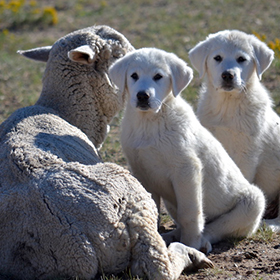| |
12 Keys to Raising
Successful Livestock Guardian Dogs
|
| |
|
By Cat Urbigkit, The Shepherd Magazine
|
| |
|
Many livestock producers have learned the value of adding livestock guardian dogs to their farms. Key factors to raising successful livestock guardian dogs include acquiring dogs from working lineages; bonding of pups to the species to be protected at an early age; and managing the dogs in a working partnership with the shepherd.
|
| |

|
| Sibling fourth-month old pups demonstrate they are well on their way to becoming effective guardians as they stick close to the side of a resting ewe.
|
|
1. Purchase pups from working parents, preferably parents that are used with the same species you want your pup to protect. Many of your fellow producers using guardian dogs will have litters of pups available on occasion, so try to find pups that from farms or ranches raising the same species that you do, whether it’s sheep, goats, or cattle. Your preference may be for purebred dogs, or for crosses between two guardian breeds, but never purchase a pup resulting from a cross with a non-guardian breed.
2. Set the pup up for success. The primary period to bond pups to the species to be guarded is between the ages of eight and 16 weeks. It’s important that the pups be placed with the livestock species they will grow up to guard during this primary bonding period.
3. Bonding pens work well to get pups off to a great start. Place a few calm and gentle ewes, goats or cows into a pen, with a protected area for the pup where he can see the livestock, but can escape to safety. Present the pup to the livestock under your supervision, but give the pup some quiet time where it can watch its new friends. The pup will get to know its livestock first through watching and sniffing noses, but will soon venture out for some gentle exploration. Visit often to supervise, but let the pup spend the majority of its time with its livestock. It’s important that the livestock penned with the pup are calm animals that will not harm the pup.
4. As the pup gains confidence in being in the company of the protected species, the flock can be released into a larger area, and/or with additional members of the flock. A gradual process of adding animals and range allows for the pup to become accustomed to its larger flock and landscape, and develop more self-confidence in its guardian duties as its body grows.
5. Give the pup attention and praise while it’s with livestock. Producers must be able to call and handle their guardians for care, so reinforce the human-dog connection, ensuring your dog is comfortable and content as your working partner.
6. Be clear in teaching the pup what you expect from it, including staying within its territory. If the pup strays from the flock, or follows you to the house, return it to the livestock. It’s a good idea to start verbal commands early, and pups will soon learn the valuable lesson, “Go to your sheep.”
|
|
|
|
